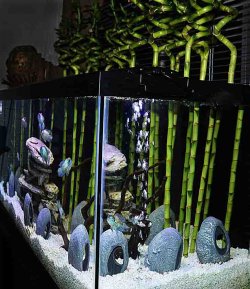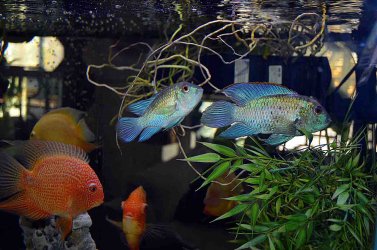Sorry in advance for the length of this!
I'm in the UK and my two water is 30ppm, but my tank runs at around 10ppm even though it is heavily stocked, so clearly my tank us dealing with all of the nitrate that the fish produce, and more. It is heavily planted and my filter deals with some of it through anaerobic activity.
Bear in mind that this means that when I do a water change I am ADDING nitrate, not diluting it. I do 2 changes a week which total about 15%. That is low by most standards, but I have done this for decades and it works. I did once decide to fall in line and tried upping this to 25% per week, but at that level I was adding too much nitrate, the tank couldn't handle it, and levels rose to 40ppm over a few months. At that level I found that plants stopped growing so well which compounded the issue and left me in a catch 22 - I needed to get plants growing again to tackle the nitrate, but I needed to get nitrate down first to make the plants grow! Water changes wouldn't help as they were what the caused the problem.
What I did was to use NitratEx resin to get it down to 15ppm. Plants then started growing again, though I had to use the resin a second time before the plants reached a sufficient rate of growth.
Although that seemed to work, I also refreshed my filter media and added some BioNitrateEx to make sure it was doing its job properly.
I have used this technique when setting up a new tank too as the same catch 22 applied.
Every tank is different as is everyone's source water, so I'm not intending to give specific advice here. However, I just wanted to point out that large scale water changes aren't always the answer, indeed, they can be the problem! Don't be afraid to use nitrate absorbing resin as a short term solution, they do have a place, and natural, nitrate reduction through biological filtration is a thing and should be encouraged. Unless you are running your filter really slowly, special media is a good idea. I used to run mine really slowly, but my current filter doesn't allow me to turn the flow down. It's beneficial to circulate your water well, but it doesn't all need to go through the filter. Your filter will work perfectly well at a turnover of once per hour if this is supplimented with a wave maker pump or similar. At that level of flow you will definitely get nitrate reduction in the filter. I did put a baffle in my faster filter to create an area of lower flow and this appeared to have an effect, however, it was a bit if a pain at cleaning time which is why I switched to special media instead.
I did once read that if nitrate falls below too low, toxins can develop. The article went into great detail, but unfortunately I can neither remember what issues might arise nor can I now find that article! I do remember that the advice was that a level of about 10ppm was probably ideal. Whether that is true I can't say, however, my tank seems to stabilise at that level because if it falls below that, my plants slow up, so on that basis alone, that level seems to be good!
I'm in the UK and my two water is 30ppm, but my tank runs at around 10ppm even though it is heavily stocked, so clearly my tank us dealing with all of the nitrate that the fish produce, and more. It is heavily planted and my filter deals with some of it through anaerobic activity.
Bear in mind that this means that when I do a water change I am ADDING nitrate, not diluting it. I do 2 changes a week which total about 15%. That is low by most standards, but I have done this for decades and it works. I did once decide to fall in line and tried upping this to 25% per week, but at that level I was adding too much nitrate, the tank couldn't handle it, and levels rose to 40ppm over a few months. At that level I found that plants stopped growing so well which compounded the issue and left me in a catch 22 - I needed to get plants growing again to tackle the nitrate, but I needed to get nitrate down first to make the plants grow! Water changes wouldn't help as they were what the caused the problem.
What I did was to use NitratEx resin to get it down to 15ppm. Plants then started growing again, though I had to use the resin a second time before the plants reached a sufficient rate of growth.
Although that seemed to work, I also refreshed my filter media and added some BioNitrateEx to make sure it was doing its job properly.
I have used this technique when setting up a new tank too as the same catch 22 applied.
Every tank is different as is everyone's source water, so I'm not intending to give specific advice here. However, I just wanted to point out that large scale water changes aren't always the answer, indeed, they can be the problem! Don't be afraid to use nitrate absorbing resin as a short term solution, they do have a place, and natural, nitrate reduction through biological filtration is a thing and should be encouraged. Unless you are running your filter really slowly, special media is a good idea. I used to run mine really slowly, but my current filter doesn't allow me to turn the flow down. It's beneficial to circulate your water well, but it doesn't all need to go through the filter. Your filter will work perfectly well at a turnover of once per hour if this is supplimented with a wave maker pump or similar. At that level of flow you will definitely get nitrate reduction in the filter. I did put a baffle in my faster filter to create an area of lower flow and this appeared to have an effect, however, it was a bit if a pain at cleaning time which is why I switched to special media instead.
I did once read that if nitrate falls below too low, toxins can develop. The article went into great detail, but unfortunately I can neither remember what issues might arise nor can I now find that article! I do remember that the advice was that a level of about 10ppm was probably ideal. Whether that is true I can't say, however, my tank seems to stabilise at that level because if it falls below that, my plants slow up, so on that basis alone, that level seems to be good!













